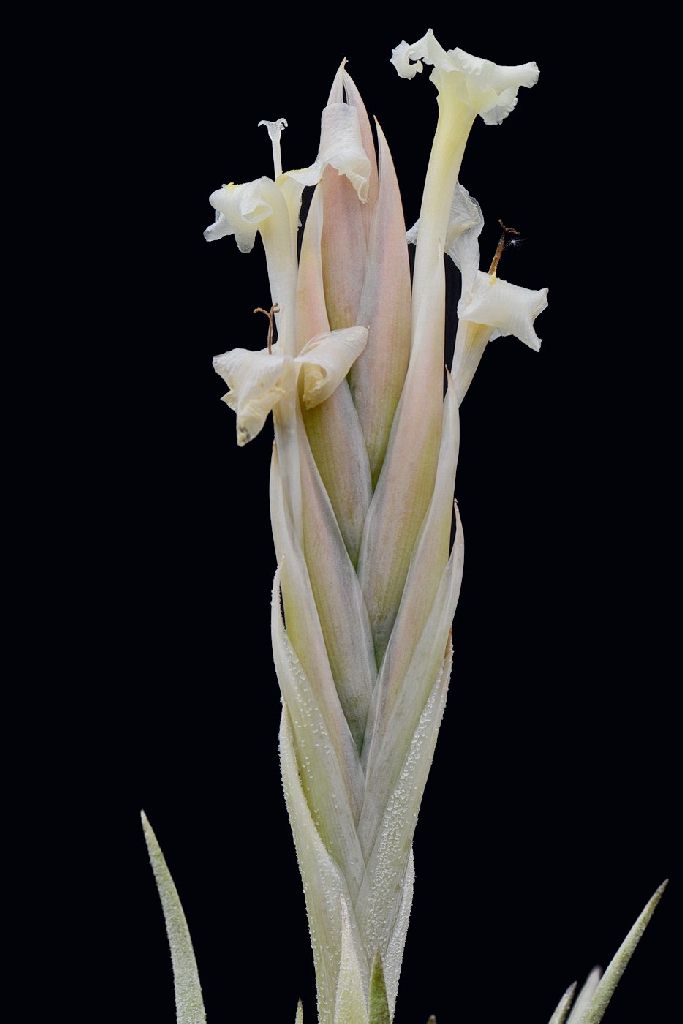
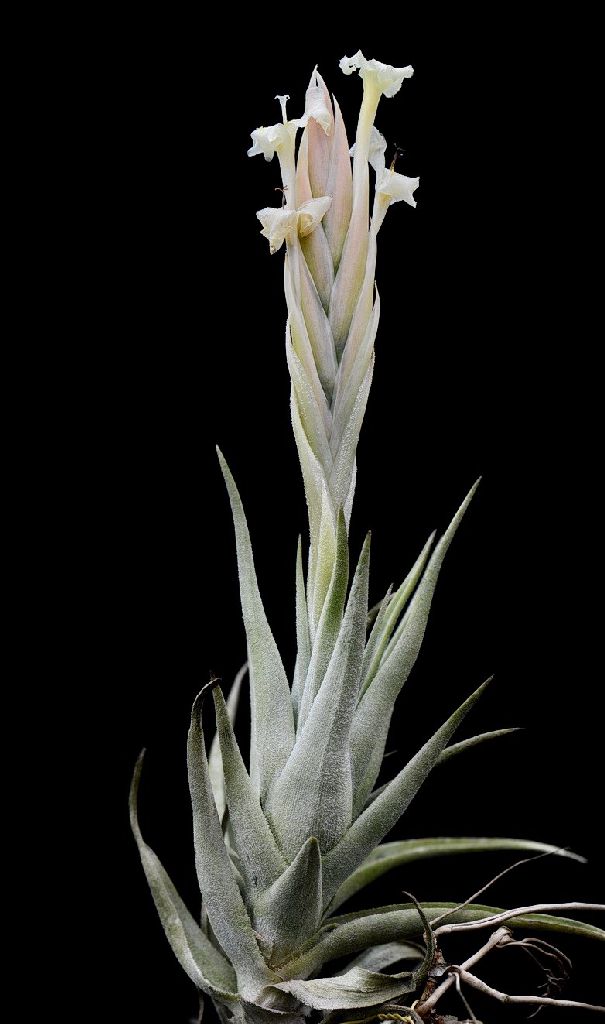
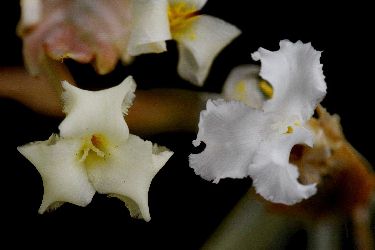
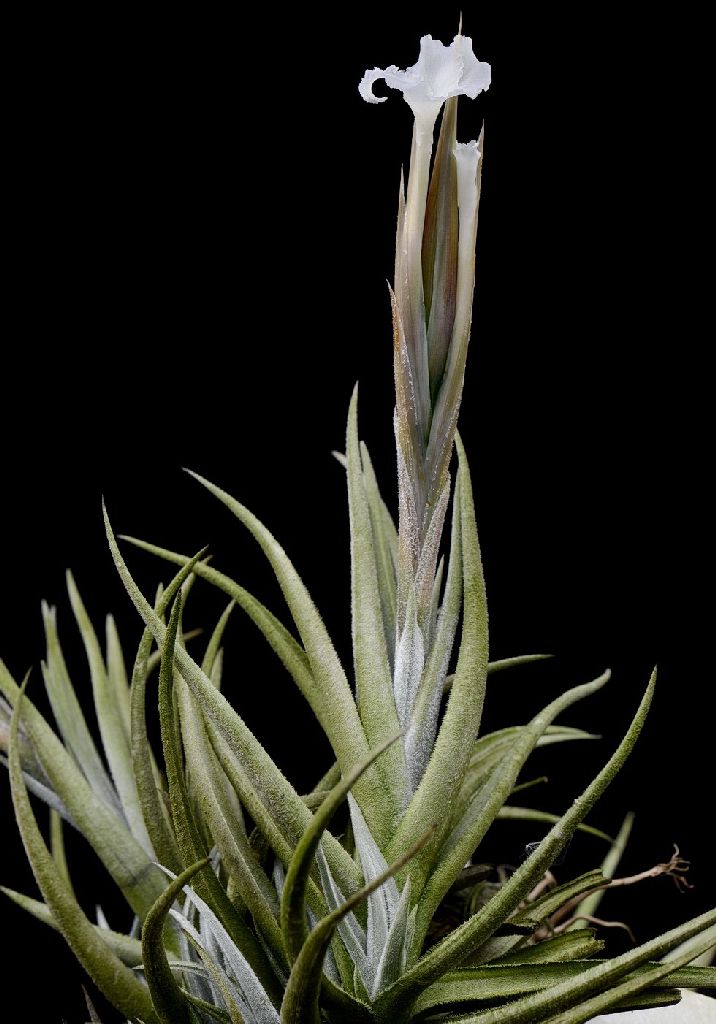
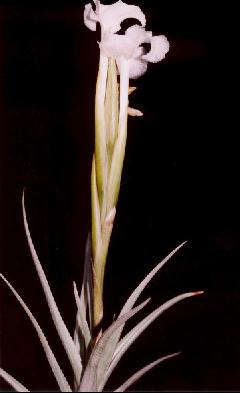
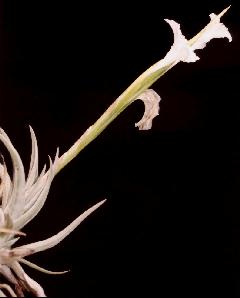
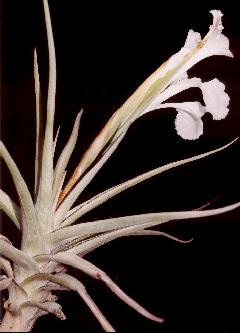
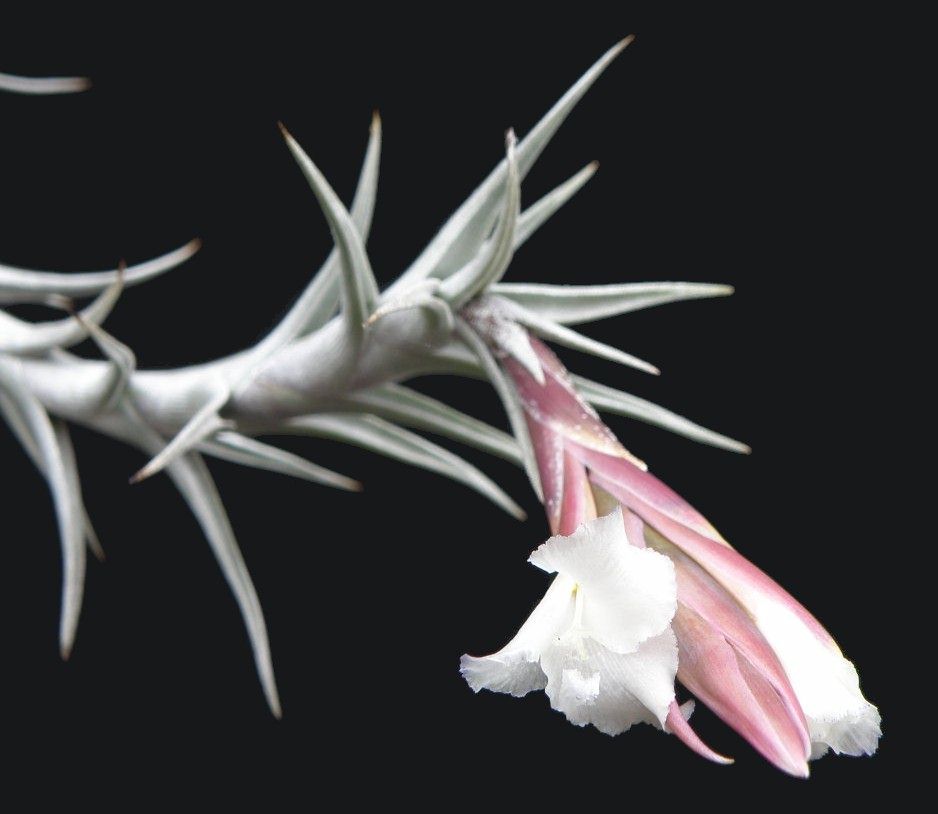
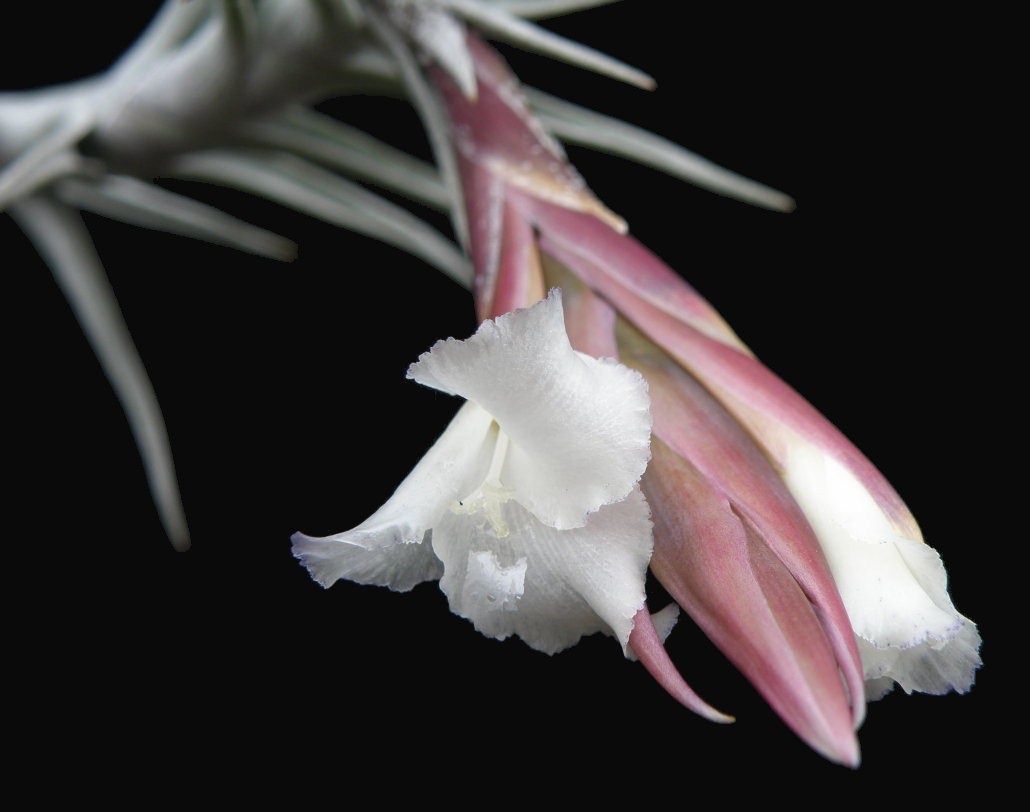
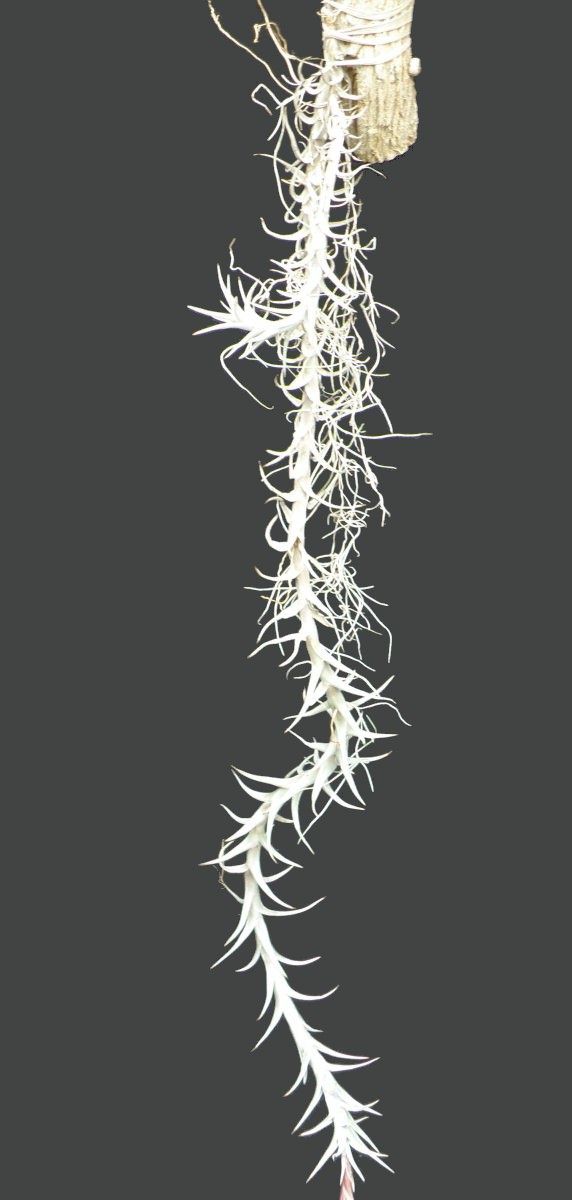
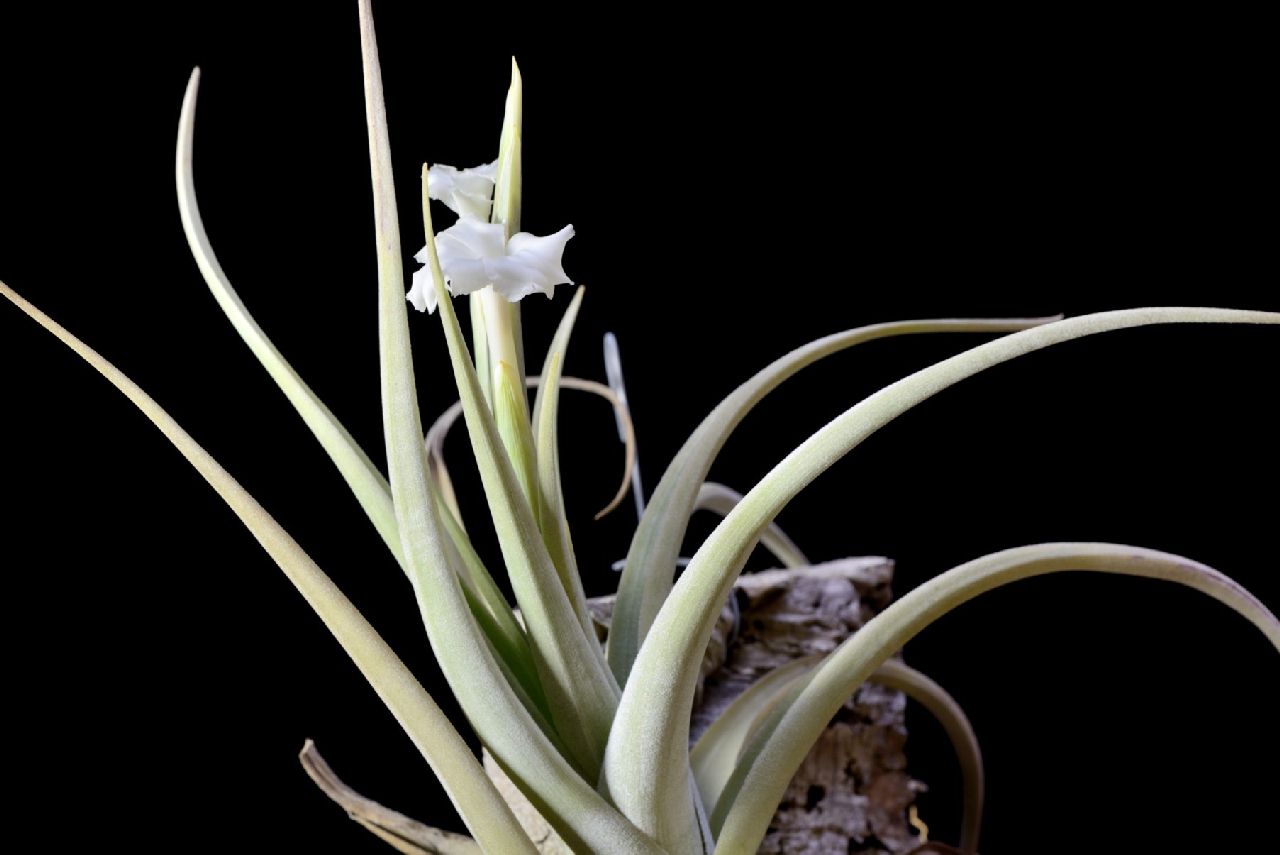
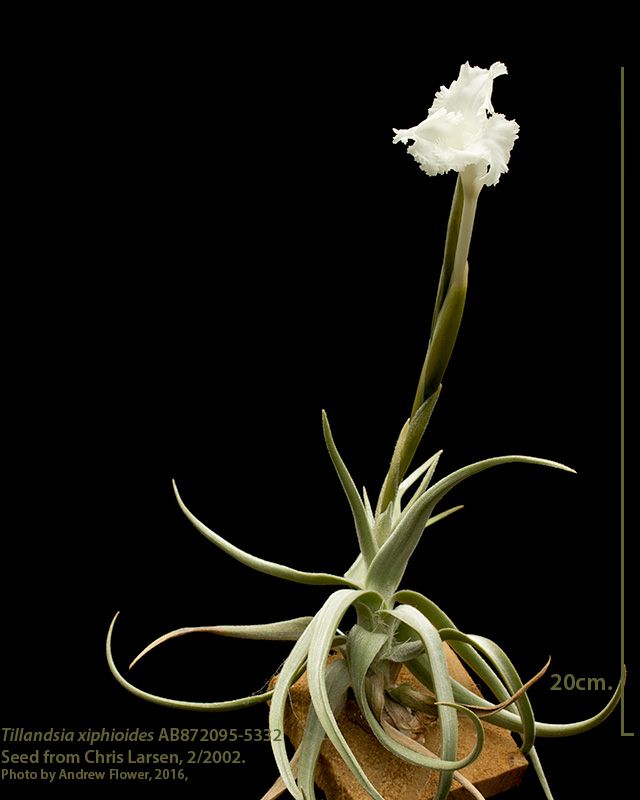
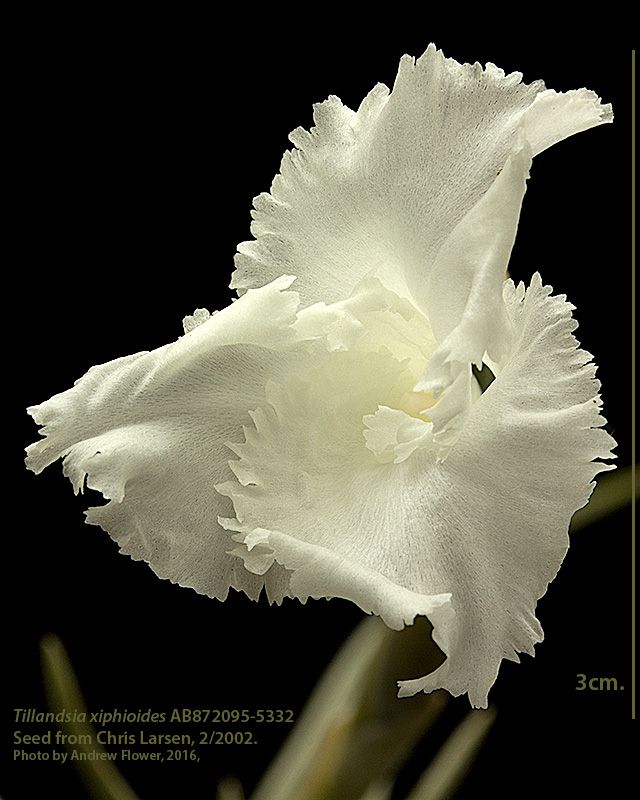
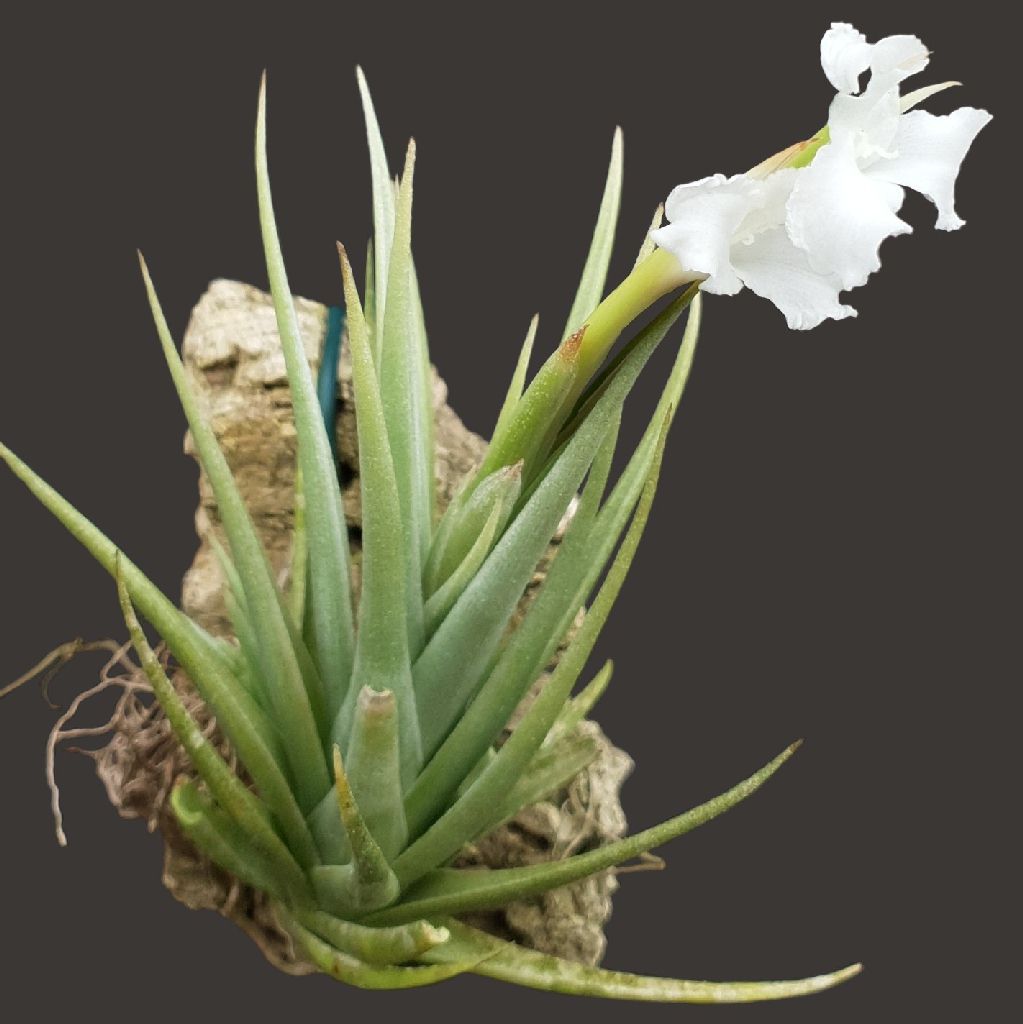
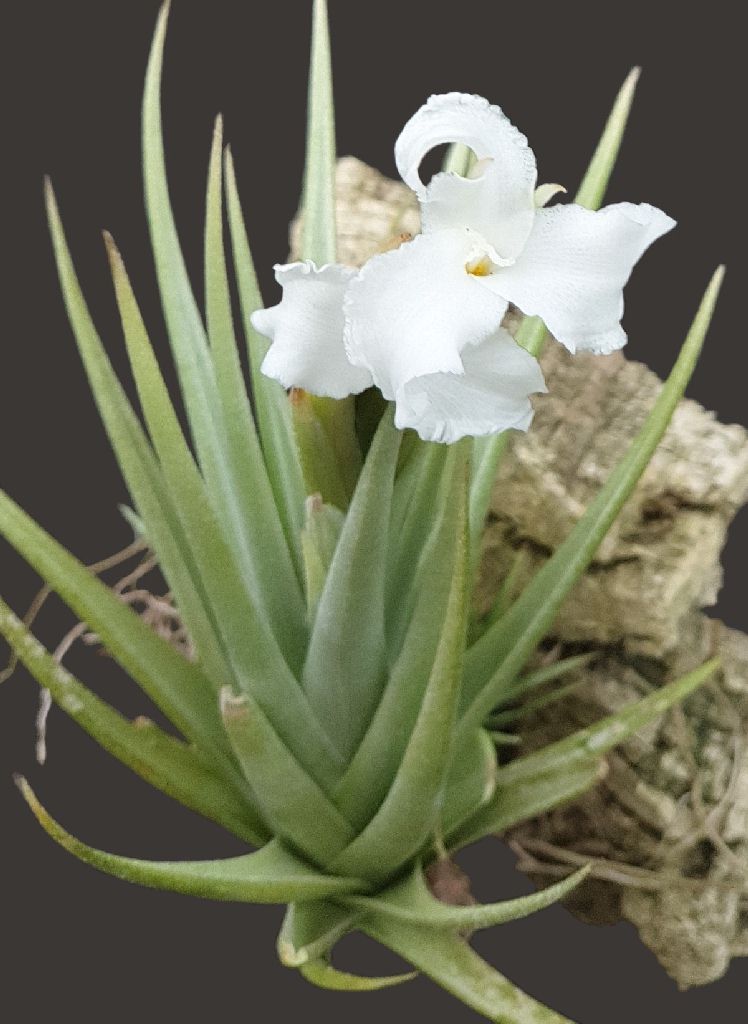
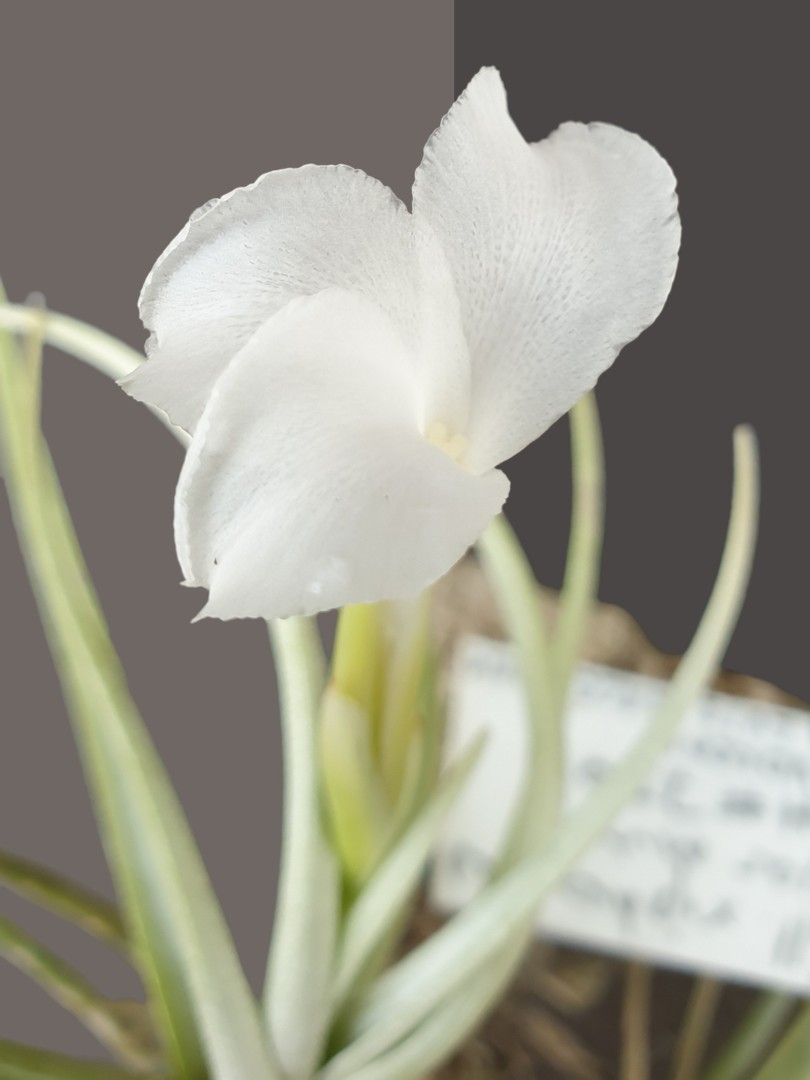
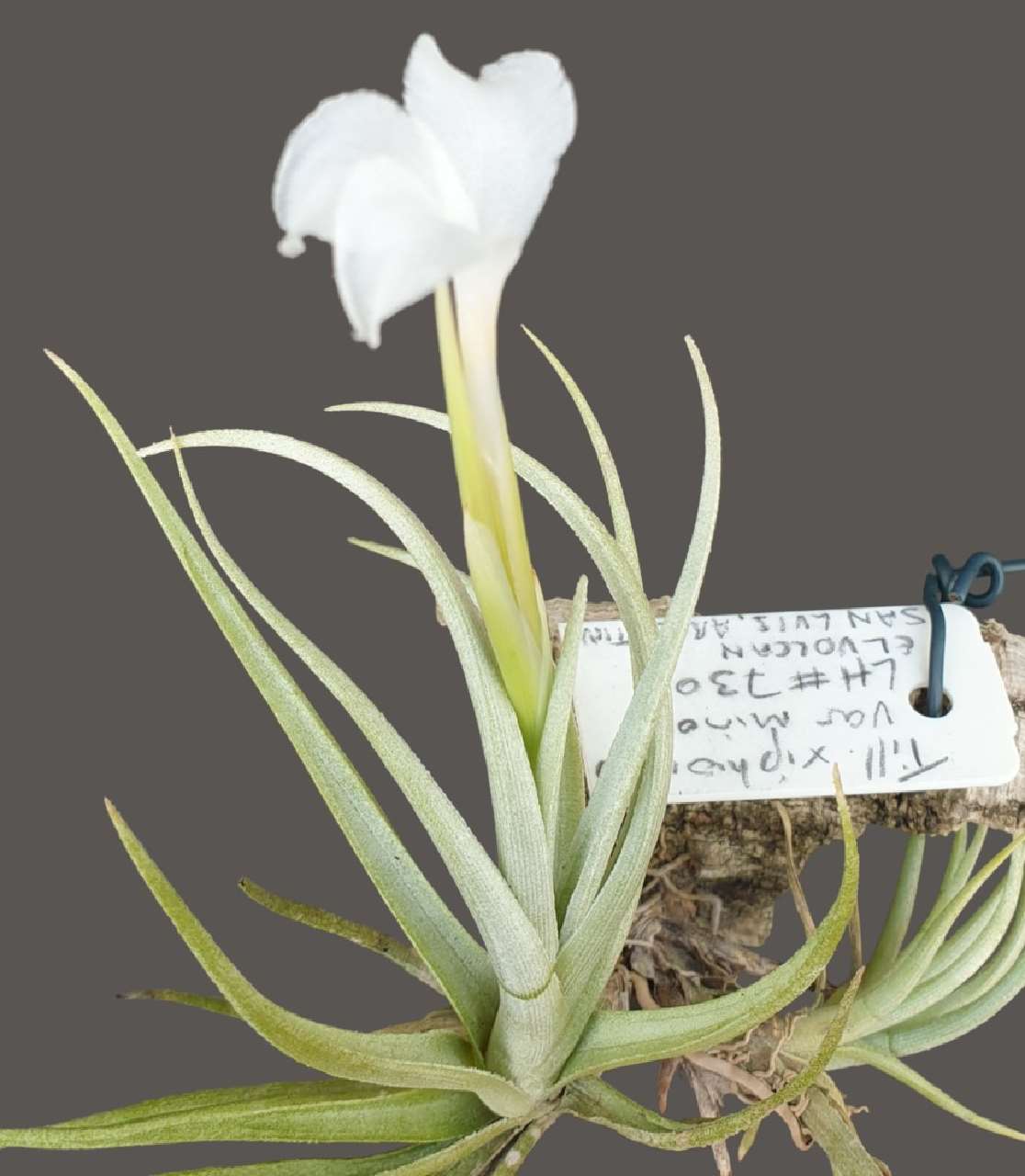
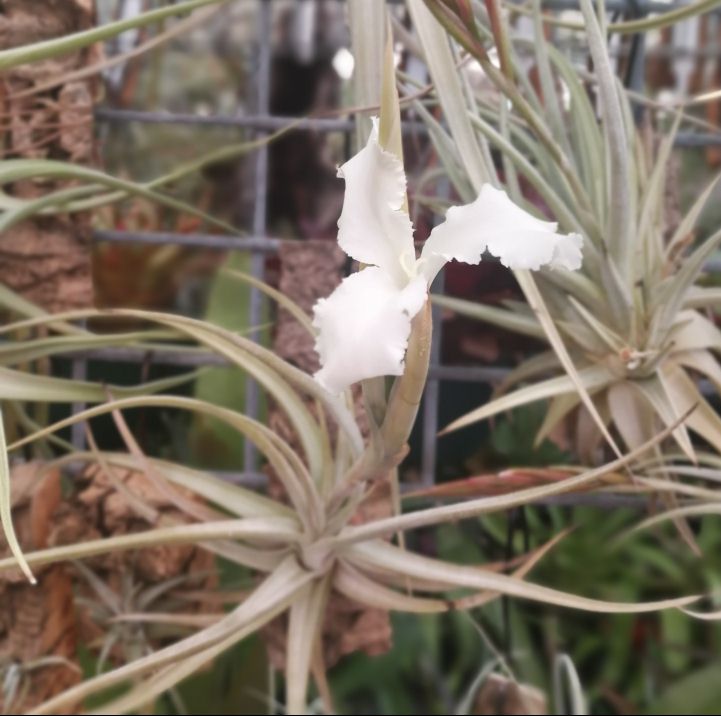
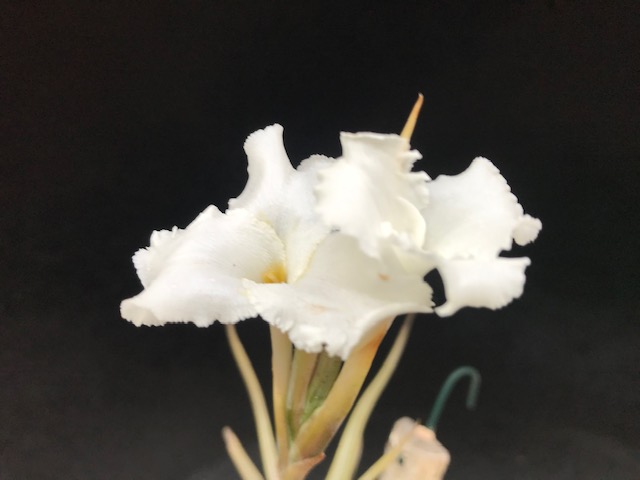
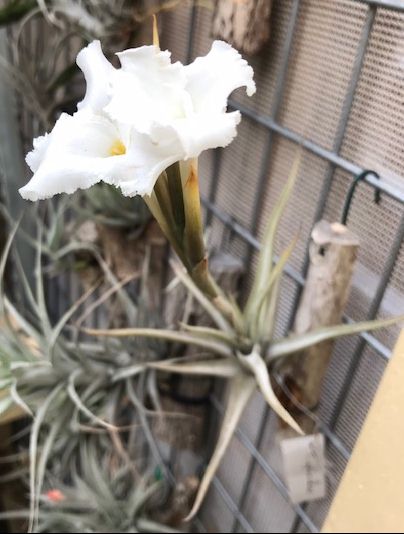
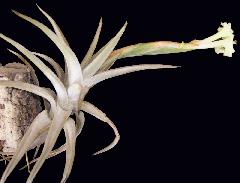
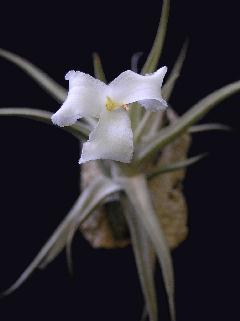
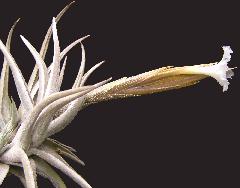
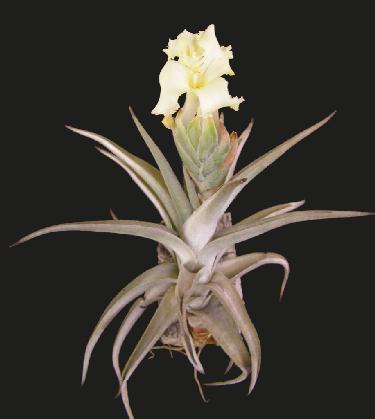
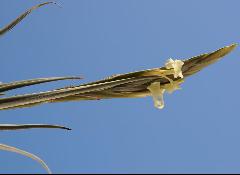
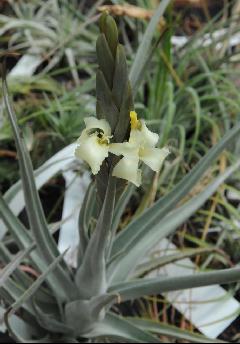
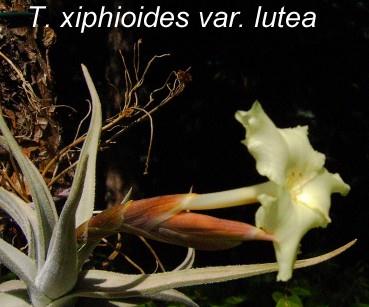
Len Colgan 29/10/13 ... "I have had T. xiphioides var lutea for many years, also from Lotte. However, it did suffer in the horrendously hot day a few years ago when hundreds of my tillandsias died, and consequently is yet to flower for me. Yes, I did travel through the state of Chuquisaca which, from memory, is directly north of the southernmost state of Tarija, and covers a lot of the Andean mountains. Hence, even at an altitude of just 1300m, I would expect to find T. xiphiodes.
The lowest altitude I ever descended to was about 1000m in Tarija, from where I collected at least three different forms of T. xiphiodes. Unfortunately, we did not go near the type location of var lutea, which is why I had to get it from Lotte herself.
I think Derek flowered it, with pale cream flowers. Is that the case, Derek?"
Derek Butcher 30/10/13 ... "Yes, I have flowered it but it must be bleaching by the Adelaide sun because I can't get the yellow that the Germans get. This got me thinking as to whether it was worthy of varietal status."
Peter Tristram 30/10/13 ... "Hi UD, I can assure you the flowers are pale yellow NOT white, just a tad more though, than in my photos. I should take a comparative pic. If I had tweaked the white balance I might have nailed the colour. Then, maybe you scored a dud colour-wise! I have at least 1 other clone budding so let’s see how yellow it is.
Len, thanks for the habitat info. 1300 m would be quite warm I imagine. Love to go there one day!"
Steve Haines 2/11/13 ... "As Peter mentioned it is xiphioides flowering time, I have a few different kinds flowering at the moment, here are some pics.
1st photo; T. xiphioides var tafiensis, large and somewhat translucent,white flower that is shortlived.
2nd; a small compact form from Maurice that come from Germany, small but brilliant white flowers.
3rd & 4th; T. xiphioides var lutea, a larger spike with definite pale yellow flowers. (I hope the photo's show the colour). As the new flowers push out they are almost a canary yellow colour that seems to fade a little as the flowers fully open.
All these plants have a beautiful fragrances, each slightly different, with xiphioides var lutea being the most pungent according to the boss,(that being Leanne)."
Peter Tristram 03/11/13 ... " (comparison photo) The photos are fine and the colour is obvious. I agree that the lutea form is the most fragrant too. Here is a comparison shot as well. Too damned hot today to take better photos!"
Len Colgan 3/11/13 ... "Thanks for sharing those pictures of forms of T. xiphioides.
I do not know whether or not it is strictly correct to label the first of them as T. xiphioides var tafiensis. The description of this variety stipulates large purple flowers, and I personally only use this name if that is the case. However, in the USA, they do not have the purple flowered form, and use the var tafiensis tag for any very scurfy forms, undoubtedly with white flowers, whether or not they come from anywhere near Tafi in Argentina.
The second form from Germany most probably originated from me. Maurice can confirm if that is the case. It is a smaller form with gun-barrel grey leaves, and was collected by the River Mizque in Bolivia.
What is really interesting about collecting T. xiphioides in Bolivia, rather than in Argentina, is that widely separated habitats yield quite different forms, making it possible to have a varied mini-collection of T. xiphioides types."
Chris Larson 3/11/13 ... "One of the things that Marj Mc & I noted on our trip – my first to Argentina – was that Isley’s tafiensis is very very similar to the form that grows right beside the road just over the ridge out of the Tafi valley – only about 1 or 2 km from the pass (& the only ones we could find at the correct altitude near the Tafi valley) – but still within the state of Tafi. I agree that this is not var tafiensis by the description. The site of the blue flowered var. tafiensis to be found near there (according to Smith & Downs) is some 10 or 15 miles away. Which I never found due to lack of detail on maps at that time – Google maps make life easier for collectors now – but AQIS makes it harder."
Derek Butcher 3/11/13 ... "I can only back Len on this one. As the DVD says -
Tillandsia xiphioides Ker-Gawler var. tafiensis L. B. Smith, Phytologia 20: 173. 1970.
Tillandsia friesii sensu Castellanos, An. Mus. Nac. Hist. Nat. Buenos Aires 37: 501, pl. 1. 1933; in part, non Mez, 1906.
Differs from Type in -
Leaf-scales with narrow lobes, making the leaves tomentose-lepidote.
Floral bracts 5-6 cm long. Sepals 30 mm long; Petals violet.
Type. Schreiter 7176 (holotype US, isotypes GH, NY, LIL), Managua (Colalao del Valle), Tafi, Tucuman, Argentina, Dec 1931.
Distribution. Epiphytic, 2000-3000 m alt, northwestern Argentina. Tucuman, Tafi: Quebrada de Amaicha, El Molle, Nov 1932, Schreiter 8835 (GH, LIL).
We have the true blue in Australia and we should not settle for second best. It took me several years to convince Rainforest Flora that they had the wrong name on their plants and there is a possibility this could be the source of wrongly identified stock. Many years ago now in trying to keep up with the latest I did import from Germany only to get white flowers. Luckily the supplier listened to my plea and on the second attempt I got the blue!
So if your 'tafiensis' flowers white please change the label to straight xiphioides. Remember here that 'lutea' only applies if the petals are a yellowish hue."
Peter Tristram 14/11/13 ... "Hi all, another white "tafiensis" from Deutschland, from a Botanic Garden as well! At least the luteas are flava."
Len Colgan 15/11/13 ... "I know that this could originate from anywhere in Argentina or Bolivia, but it does look like the Rio Mizque form from Bolivia recently shown by Grant. What is your opinion Grant?"
Peter Tristram 15/11/13 ... " I’ll ask Uwe – he has access to the Goettingen database."
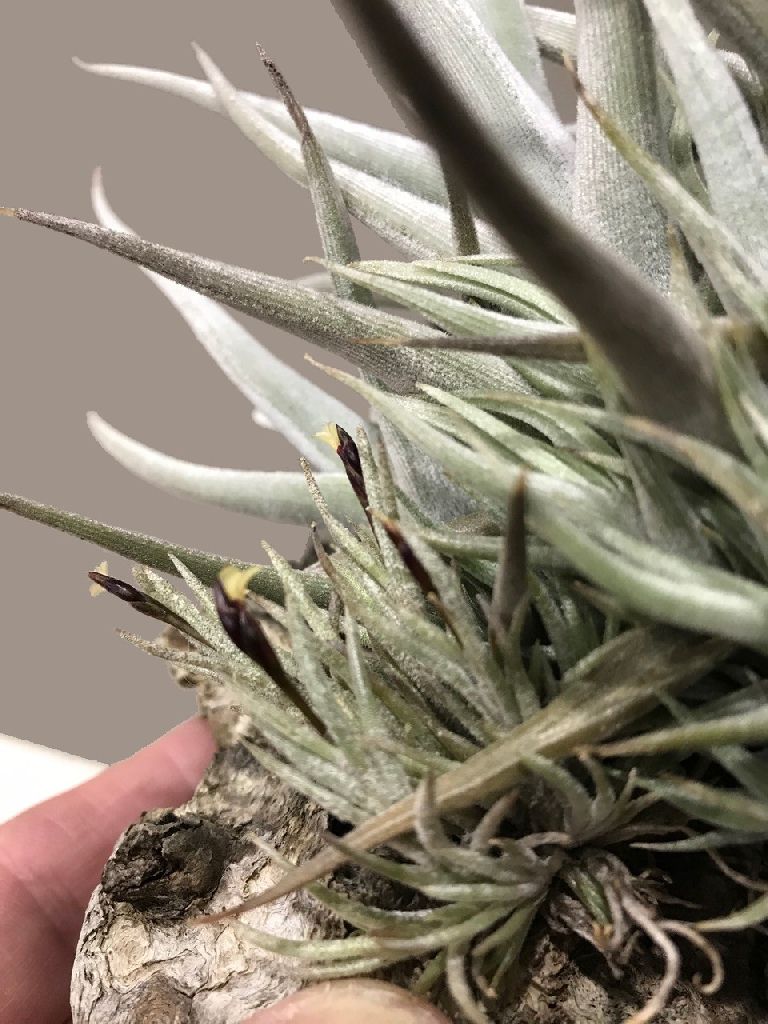
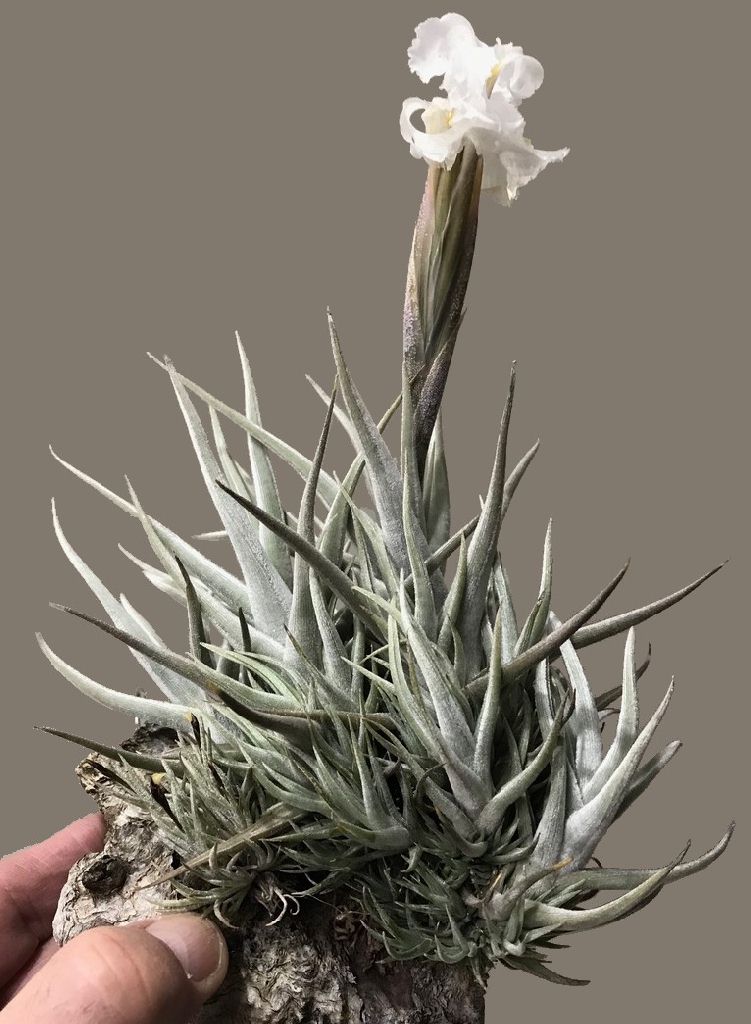
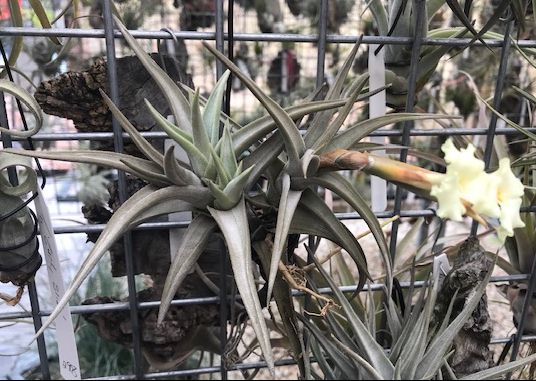
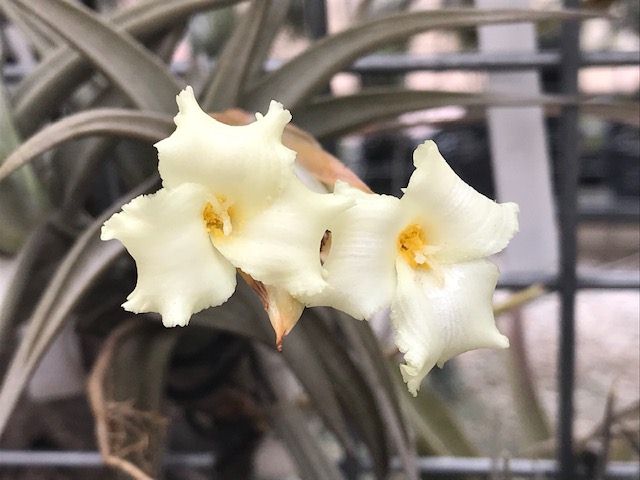
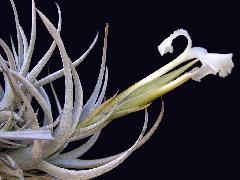
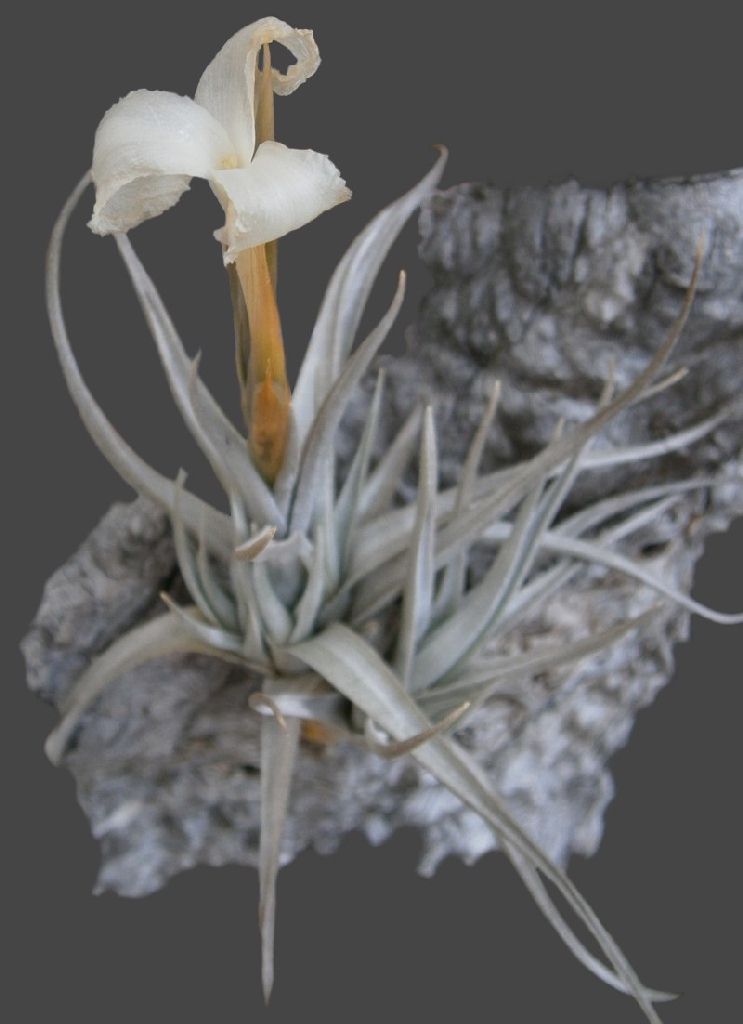
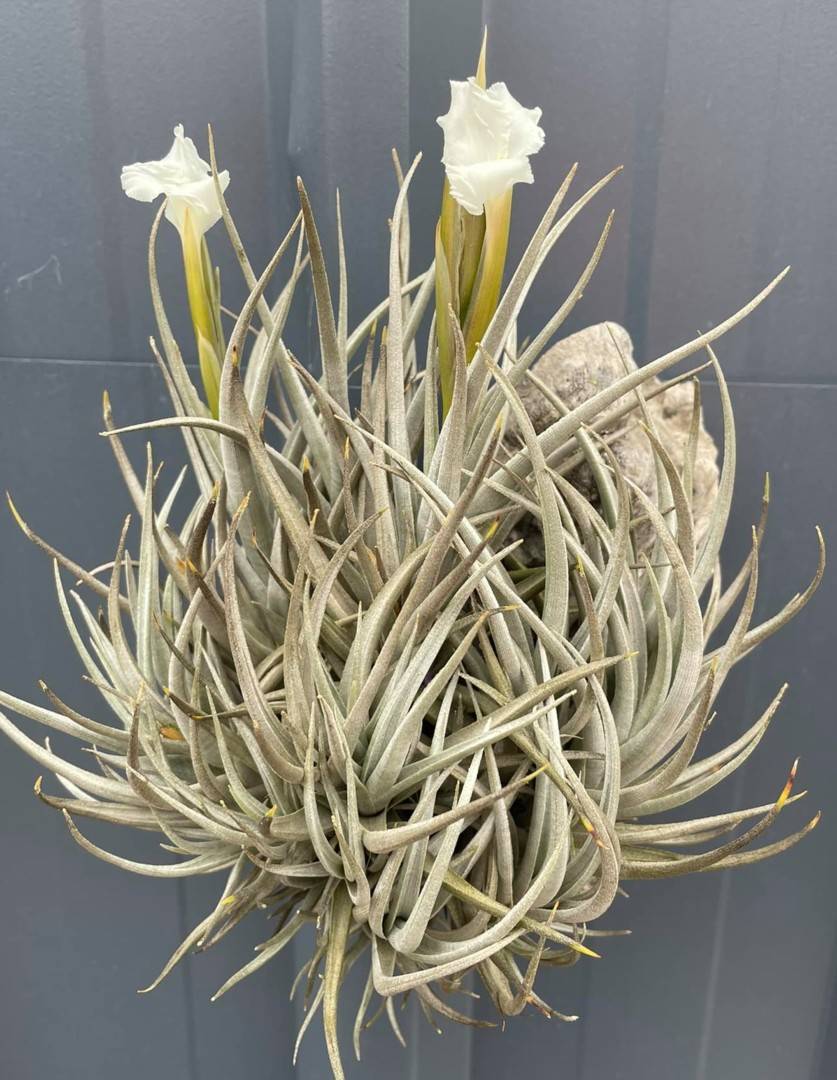
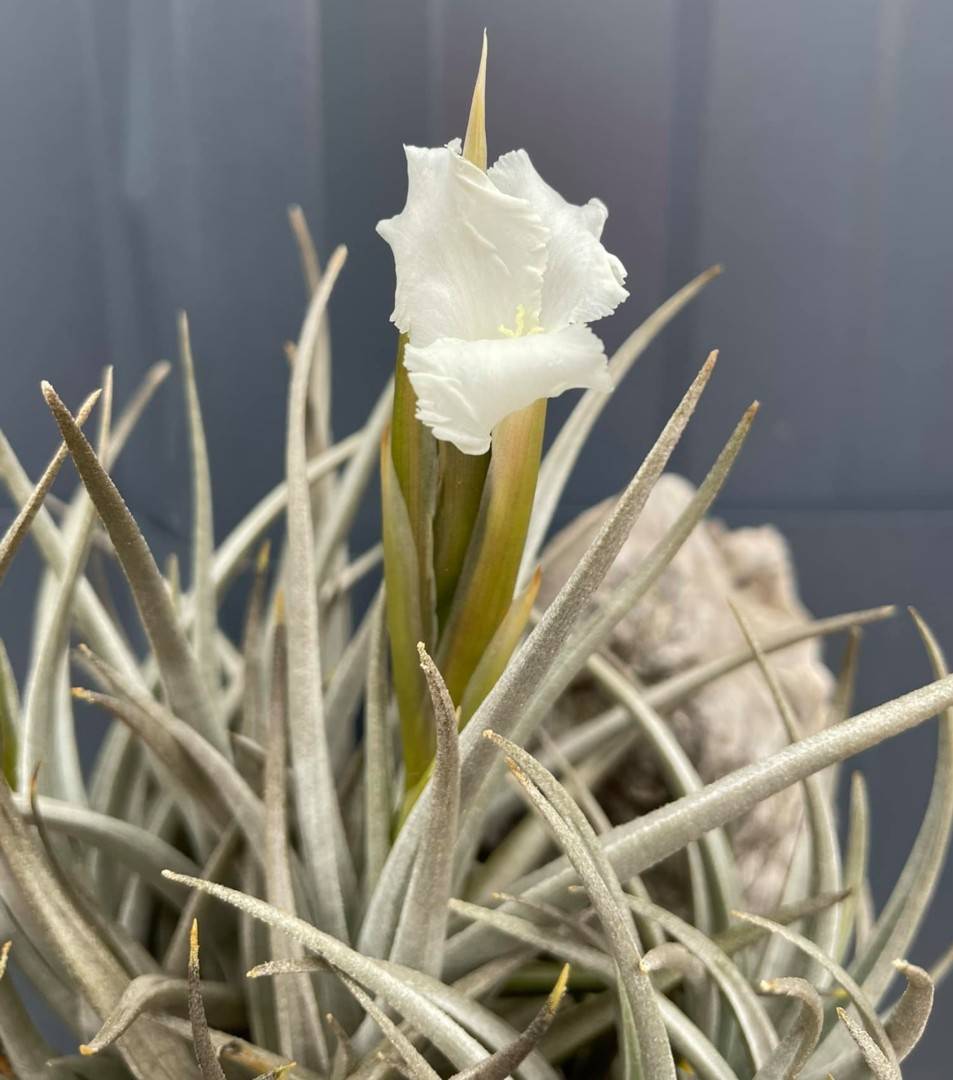
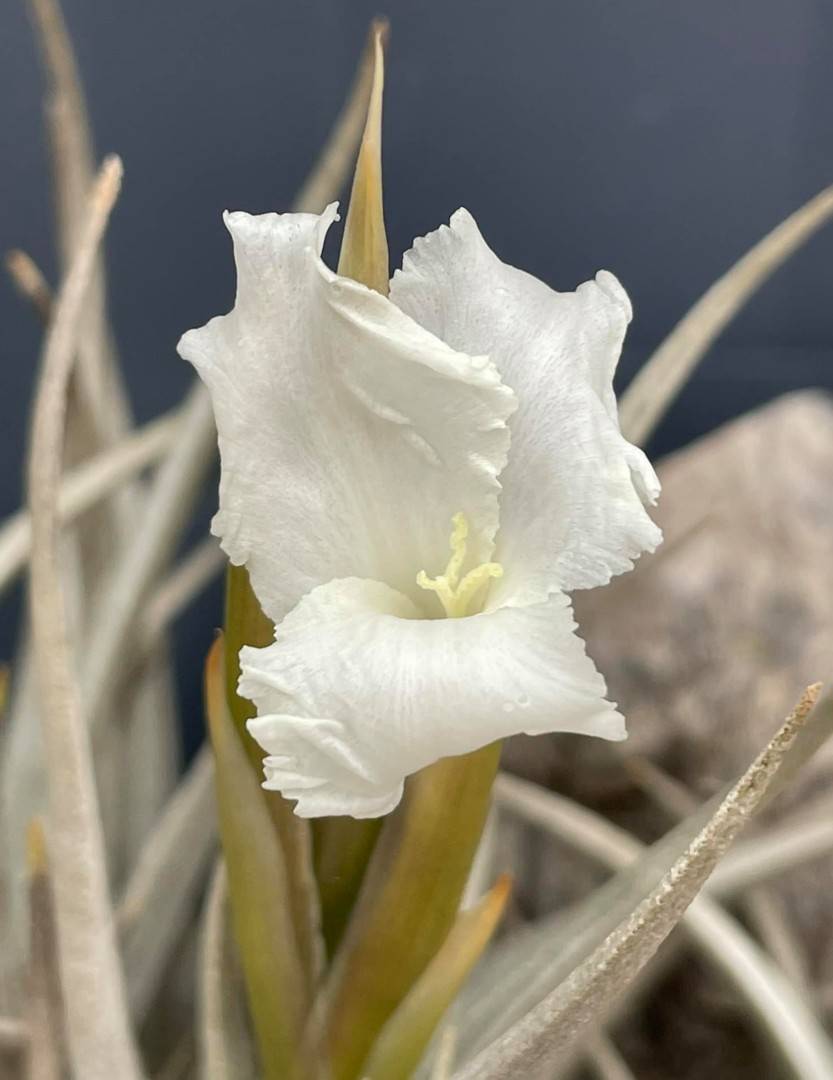
Tillandsia prolata (H. Luther) Gouda & Barfuss comb. et stat. nov.
Basionym: Tillandsia xiphioides subsp. prolata H. Luther (1996), J. Bromeliad Soc. 46(5): 211, figs 10, 11.
Type: Bolivia: Dept. La Paz, roadside from La Paz to Mecapaca, valle de la Luna, Rio Abajo, Alt. 2500 m., 5-10-1995. D. Cathcart Cathcart B-2 = Cathcart s. n in hort.
Selby: (holo SEL, iso LPB).
Tillandsia prolata is a taxon that is in between T. xiphioides and T. diaguitensis. It would be very helpful to include more species of the T. xiphioides complex in molecular studies to learn more about the relationships between these species.
Another variery that deserves to be a species to its own right is Tillandsia xiphioides var. tafiensis L.B.Sm. (1970).It has variously purple-blue petals like several other species from the Tillandsia xiphioides complex and has a different form of indumentum (strongly asymmetric trichomes). More study is needed to compare this species with other species of the Tillandsia xiphioides complex (see also Hromadnik 1989, 1990, 1991), like Tillandsia gerdae Ehlers (1987), Tillandsia cochabambae E.Gross & Rauh (1986) and Tillandsia recurvispica L.Hrom. & P Schneider (1987).
Tillandsia tafiensis (L.B. Sm.) Gouda comb. et stat. nov.
Basionym: Tillandsia xiphioides var. tafiensis L.B.Sm. (1970), Phytologia 20: 173.
Type: Argentina: Prov. Tucuman, Tafi, Managua, Alt.2000 m. 12-1931. R. Schreiter 7176 (holo US, iso GH, K, LIL, NY).
The forms shown here are just a few of the many variations found within the wild populations of Tillandsia xiphioides. I do not think it would be very helpful to describe each form as an infraspecific taxon of Tillandsia xiphioides: enough intermediate forms can be found to completely confuse the definitions of any infraspecific groups we try to describe.
167. Tillandsia xiphioides Ker-Gawler, Bot. Reg. 2: pl. 105. 1816.
Desc from S&D
Plant flowering 15-30 cm or higher; roots present; stem from very short to 15 cm long, simple or few-branched.
Leaves numerous, polystichous but sometimes almost distichous, erect to spreading, more or less curved or contorted, to 25 cm long but often much shorter, densely cinereous- or ferruginous-lepidote;
Sheaths large, densely imbricate, making the stem appear 1-2 cm in diameter, passing imperceptibly into the blades;
Blades narrowly triangular, subulate-attenuate, flat, to 2 cm wide.
Scape from almost none to 12 cm long but always much obscured by the upper leaves, erect;
Scape-bracts densely imbricate and covering the scape, elliptic-oblong, thin, the lower ones caudate and lepidote, the upper apiculate and nearly or quite glabrous.
Inflorescence always simple and distichous, lance-oblong, acute, to 12 cm long without the petals, 2-10-flowered;
rhachis flexuous to 3 mm in diameter, narrowly alate.
Floral bracts densely imbricate, usually several times longer than the internodes, lance-oblong, acute, to 7 cm long, much exceeding the sepals, ca 14 mm wide, submembranous, strongly nerved with a broad scarious nerveless margin, glabrous or sometimes the lower ones sparsely lepidote, stramineous or suffused with red or violet, ecarinate;
Flowers sessile, to 10 cm long.
Sepals linear-lanceolate, acuminate, to 42 mm long, free glabrous, submembranous, prominently nerved, the posterior carinate;
Petals white or violet, fragrant, the claw linear, blade broadly elliptic, obtuse, spreading, ca 2 cm wide, conspicuously crenate-serrate;
Stamens elongate, barely included or exserted from the throat of the corolla;
filaments filiform, straight; anthers linear, 8 mm long; pistil exserted; style slender;
Ovary slenderly prismatic.
Capsule stout, abruptly short-beaked, 3 cm long:
Key to subspecies and vars of T. xiphioides
1 Petals white => 2
1 Petals other colours => 3
2.. Plant stemless, petals 6-9 mm => var minor
2.. Plant stem from very short to 15 cm long petals to 2 cm wide => var xiphioides
2.. Plant stem mostly about 25-40 cm long => subsp prolata NOW SPECIES IN OWN RIGHT
3... Petals yellow => var lutea
3... Petals blue => var. tafiensis NOW SPECIES IN OWN RIGHT
Tillandsia xiphioides Ker-Gawler var. xiphioides
Tillandsia suaveolens Lemaire, Ann. Soc. Royale d'Hortic. Paris 179. 1843. Type. Deschamps Hortus in Morren Icon (K).
Anoplophytum xyphyoides Beer, Bromel. 254. 1857; nomen.
Tillandsia macrocnemis Grisebach, Symb. Argent. Gott. Abh. 24: 332. 1879.
Type. Near Cordoba, Argentina, Hieronymus 423 (CORD, GOET, US photo), Feb 1876.
Phytarrhiza xiphioides (Ker-Gawler) E. Morren, Belg. Hortic. 29: 370. 1879.
Tillandsia sericea Hortus ex E. Morren, Belg. Hortic. 29: 370. 1879; nomen.
Tillandsia odorata Gillies ex Baker, Jour. Bot. London 25: 214. 1887; nomen. Based on Gillies s n (BM, GH), Mendoza, Argentina.
Tillandsia xiphoides E. Morren ex Wittmack in Engler & Prantl, Nat. Pflanzenfam. 2 (Abt. 4): 57. 1888; error.
Tillandsia unca Hicken, Physis I: 26. 1912; non Grisebach, 1874. Based on Pastore s n (SI).
Leaf-scales mostly with broad lobes.
Floral bracts to 7 cm long.
Sepals to 42 mm long;
Petals white
Type. Probably none extant. Species adequately typified by original description and plate.
Distribution . Epiphytic and saxicolous in dry habitats, 700-2600m alt, Bolivia, southern Brazil, Paraguay (! Mez), Uruguay, northern Argentina.
BOLIVIA. Cochabamba: Cerro San Pedro, 14 Oct 1956, Jimenez 24 (US). Potosi, Nor Chichas: San Antonio, Dec 1931, Cardenas 93 (GH, SI). BRAZIL. Rio Grande do Sul: Gruta de Lourdes, Sao Pedro de Alcantara, 1 Nov 1950, Schultz 767 (US); 25 Sep 1965, Reitz 6770 (HBR). URUGUAY. San Jose: Sierra Mahoma, 1939, Chebataroff s n (MVM); s d, Larriera s n (MVM). ARGENTINA.Jujuy: Tilcara, 16 Feb 1926, Venturi 6889 (US); 27 Jan 1940, Cabrera7702 (GH); Est. Volcan, 20 Jan 1927, Castillon 315 (GH, LIL). Salta: Capital, Dec 1913, Rodriguez s n (GH, LIL, NY); Cafayate, 27 Dec 1913, Rodriguez 1201 (BA, GH, US); 7 Jan 1914, 1252 (US); 19 Oct 1948, Skottsberg s n (GB); La Candelaria, 5 Oct 1931, Schreiter 6735 (GH):Catamarca: Andalgala, 26 Sep 1915, Jorgensen 1105 (GH); Punta Balastro, Santa Maria, 2l Dec 1933, Peirano s n (GH, LIL). Tucuman: La Florida, Dec 1896, Bruch s n (NY); Campo de las Arcas, Trancas, 3 Feb 1917, Schreiter 5523 (GH, NYI Quebrada de La Hoyada, Tafi, 25 Sep 1920, Schreiter 1377 (GH, LIL, US); 23 Nov 1921, 1099 (LIL, US); Raco, Trancas, 23 Nov 1920, Venturi 1316 (MVM, US, Z); Rio Loro, Burruyacu, 5 Nov 1923, Venturi 2495 (US); Sierra de la Candelaria, Trancas, 20 Oct 1924, Venturi 2495 (BM); 2495-A (GH); Colalao to Tolombon, 19 Oct 1948, L. B. Smith 4646 (US). La Rioja: Sierra Velasco, Jan 1879, Hieronymus & Niederlein 9 (CORD); Sierras Ulapes, San Martin, s d, Stuckert 13244 (CORD); Chamical, Dec l895, Bodenbender in Kurtz 8923 (CORD); Quebrada de Penon, 17 Jan 1907, Kurtz 14239 (CORD). San Juan: Jachal, 28 Feb 1937, Spegazzini s n (BAB). Mendoza: Cacheuta, Nov 1913, Sanzin 276 (MVM); without exact locality, Miers 640 (BM); Gillies s n (BM, GH). Cordoba: Sierra de Cordoba, Rio_Primero, Sep 1874, Hieronymus s n (NY); Cordoba, Nov 1877, Hieronymus 912 (CORD, F, GH, GOET, US); 1879, Lorentz 123 (BM, GH); Dec 1891, Kuntze s n (NY); s d, Stuckert 3506 (G); Sierra Achala, Jan 1895, Kurtz 8413-A (CORD); San Vicente, 10 Nov 1899, Stuckert 7606 (G); Estancia San Tiodoro, Rio Primero, 13 Oct 1904, Stuckert 14473 (CORD); Dean Funes, Dec 1910, Lillo 10718 (GH, LIL); 30 Nov 1916, Sanzin 1156 (MVM); Capilla del Monte, Sierra Chica, 29 Apr 1918, Osten 13465 (MVM); 22 Oct 1923, 17114 (MVM); Serrezuela, 8 Dec 1942, Bartlett 19223 (MICH, US).
Tillandsia xiphioides Ker-Gawler ssp. prolata H. Luther J. Brom. Soc.46: 211-2. 1996
A Tillandisa xiphioides Ker-Gawler typo et varietatibus affinis, sed caule inflorescentiaque longiore differt.
TYPE. Bolivia. La Paz: roadside from La Paz to Mecapaca, Valle de la Luna, Rio Abajo, 2500-3000 m elev., Aug. 1993, D. Cathcart B-2 legit, flowered in cultivation, 5 Oct. 1995, D. Cathcart s.n. (holotype: SEL; isotype: LPB).
Plant a caulescent, sometimes rootless, mound-forming lithophyte or terrestrial (!D. Cathcart);
flowering 40-75 cm tall.
Leaves densely imbricate along the stem, stiffly sub erect to spreading, 12-20 cm long, silver-grey.
Leaf blades narrowly triangular, attenuate, 5-10 mm wide, somewhat nerved, rigid but not especially succulent.
Scape erect, 12-18 cm X 2- 3 mm.
Inflorescence lanceolate, 8-15 X 1-2 cm, distichously 3 to 5-flowered.
Floral bracts narrowly elliptic, acute, 45-58 mm long, thin-coriaceous, nerved, pale green to yellow-tan.
Flowers opening in the late afternoon and remaining open 24-48 hours, strongly and sweetly fragrant at all times.
Sepals narrowly elliptic, acute to acuminate, 33-36 mm long, thin-coriaceous, nerved, the adaxial pair carinate, pale green.
Corolla with spreading to re flexing blades.
Petals oblanceolate, obtuse, 7-8 cm long, the margins of the blade becoming strongly undulate, white.
Stamens and style exserted due to the reflexing of the petal blades.
The Valle de la Luna site represents both a very high elevation and northwest outpost for Tillandsia xiphioides. The habit of the plant is also unique within the complex of T. xiphioides; in fact the collector expected the plants (sterile when collected) to be some form of T. latifolia Meyen or T. incarnata HBK based on their appearance.
The long leafy stem, thinner, scarcely succulent leaves and rather elongate inflorescence at once separates this taxon from all the described varieties of T. xiphioides but the bract and flower size and structure seems consistent enough to include it at the sub specific level. Actually, the reproductive structures and phenology show much more congruence with the type of this species than do those of the variety tafiensis L. B. Smith. The latter seems more similar to the complex of T. zecheri W. Till.
Similar long-stemmed populations of Tillandsia have been described within the species of T. ionantha Planchon and are also known to exist in certain high elevation populations of T. latifolia var. divaricata Bentham; the latter plant is often a stemless epiphyte at sealevel and a caulescent (to nearly 1 m long) lithophyte at 1500-2500 m in Ecuador.
Tillandsia xiphioides Ker-Gawler var tafiensis L. B. Smith, Phytologia 20: 173. 1970.
Tillandsia friesii sensu Castellanos, An. Mus. Nac. Hist. Nat. Buenos Aires 37: 501, pl. 1. 1933; in part, non Mez, 1906.
Description from S&D
Differs from Type in:
Leaf-scales with narrow lobes, making the leaves tomentose-lepidote.
Floral bracts 5-6 cm long.
Sepals 30 mm long;
Petals violet.
Type. Schreiter 7176 (holotype US, isotypes GH, NY, LIL), Managua (Colalao del Valle), Tafi, Tucuman, Argentina, Dec 1931.
DISTRIBUTION. Epiphytic, 2000-3000 m alt, northwestern Argentina. ARGENTINA. Tucuman, Tafi: Quebrada de Amaicha, El Molle, Nov 1932, Schreiter 8835 (GH, LIL).
Tillandsia xiphioides Ker-Gawler var. lutea L Hromadnik Die Bromelie 1/1990 p12-15
Plant flowering to 20cm high.
Leaves to 15cm long, dense erect silvery lepidote
Scape 5 – 10cm long, covered with scape bracts.
Inflorescence simple, 2cm wide, to 10cm long, a tipped lanceolate sword shape.
Flowers sessile, scented.
Flower bracts 5 – 6cm long, tipped lanceolate, unkeeled, green, rarely with violet-red overlay, smooth, glabrous, the underneath scattered lepidote, much exceeding the sepals.
Sepals 3 – 3.7cm long, the posterior pair sharply keeled and connate for 2mm, green.
Petals 7 – 9cm long, yellow, platte broad-oval, the edges serrated and strongly wavy
Style the upper third yellow
Type locality Bolivia, Dept. Chuquisaca, Prov. Luis Calvo, single or in small groups on vertical cliffs in Serrania Inca Huasi in the neighbourhood of Ortes Muyupampa, 1300m alt, leg H&L Hromradnik Nr.5212, 27 July 1979 (WU)
Differs from Type in:
Petals yellow
Habitat different
Tillandsia xiphioides Ker-Gawler var. minor L Hromradnik Die Bromelie 3/ 1989 p65
Plant stemless, growing on rocks in groups, flowering to 10cm high.
Leaves ca. 8cm long, at the base 2cm wide, next to sheath 8mm wide, strongly grooved, erect, somewhat secund and forming a small rosette.
Scape missing or very short, enclosed by scape bracts.
Inflorescence to 8cm long, 0.8cm wide, 2 – 3 flowered, tipped lanceolate, green.
Flowers sessile, scented.
Flower bracts to 45mm long, glabrous, green, tipped lanceolate.
Sepals to 30mm long, nerved, glabrous, thin membranous, green, the posterior pair short connate and sharply keeled.
Petals white, to 75mm long, platte 6 – 9mm wide, lanceolate, tipped, more or less spirally twisted, edges serrate.
Type locality Argentina, Prov. San Luis, on steep rocks in the Sierra de San Luis above San Francisco del Monte del Oro, 1200m alt, leg H&L Hromadnik Nr. 7315, August 1981 Holotype (WU)
Differs from Type in:
Plant smaller
Flowers smaller
Petals narrower